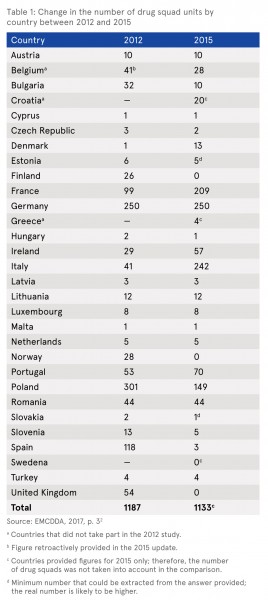Guiney, Ciara (2018) Drug squads: units specialised in drug law enforcement in Europe. Drugnet Ireland, Issue 66, Summer 2018, pp. 26-27.
| Preview | Title | Contact |
|---|---|---|
|
PDF (Drugnet 66)
1MB |
Drug law enforcement via specialised drug units was identified by the European Monitoring Centre for Drugs and Drugs Addiction (EMCDDA) as an important route to reducing drug supply in Europe.1 In 2014, the EMCDDA conducted a follow-up study of their earlier paper with the aim of monitoring changes in the quantity of specialised drug squads and how they are staffed.2
Methodology
The data for this study were collected between 2012 and 2015. National reference persons from 28 EU member states, Norway and Turkey were invited to complete a short questionnaire, which contained items from the original study and options to provide further information. Only 12 participants from the original study completed the updated question; the remaining 18 were completed by new reference persons.
Results
Drug squads in Europe in 2012 and 2015
The reported drug squad units (DSUs) were located within different organisational structures, such as police forces, customs, and other law enforcement agencies. In consequence, there were differences between functionality, administrative and territorial levels. Overall, as shown in Table 1, the total number of DSUs decreased across Europe between 2012 and 2015. However, in Ireland, the number of DSUs nearly doubled, increasing from 29 (2012) to 57 (2015).
Staff numbers within drug squads in Europe
Overall, there was a 5% increase in the number of staff employed in DSUs between 2012 (19,490) and 2015 (20,515) across Europe. A further breakdown at a national level indicated that some countries showed an increase, for example, the Netherlands and Turkey. Other countries showed a decrease, for example, Austria and Hungary. Three countries, Germany, Latvia and Romania, reported no changes to staff levels between 2012 and 2015. In relation to Ireland, an increase in staffing levels was shown. Although the total number of employees assigned to DSUs increased by approximately 3%, the total number of officers assigned to DSUs was more than double that amount (7.45%).
Drug law enforcement in countries without drug squads
Several countries indicated that specialised drug law enforcement units did not exist in their countries (Finland, Sweden, United Kingdom and Norway). The reason put forward for this was organisation restructuring that resulted in drug units being reintegrated into serious organised crime units.

Changes in the mandates of drug squads
- Technical mandates and terminology: Mainly, across European countries, technical aspects of drug law enforcement are not standardised. Notably, little or no changes have occurred since 2012. In addition, there are disparities in the type of terminology that is used.
- Territorial mandates: This refers to the ‘jurisdiction within which the responsibility and operations of a drug squad extend’ (p. 7). Drug squads can be assigned to one of four types: international, national, regional, and local. No major changes were shown since 2012.
- Drug law enforcement functions: The majority of drug law enforcement units (n=26) fulfil their technical mandates utilising multiple functionality (p. 9):
– Case management, which refers to evidence that is provided to the prosecution.
– Intelligence management, which refers to the process involved in obtaining and processing of information and how it is made available to law enforcement.
– Operations, which refers to all overt and covert operations that aim to reduce drug supply.
Limitations
A number of limitations have been identified. For example, figures for staff assigned to drug units need to be interpreted with caution as it is likely that some countries may have under-reported the total number of staff. Moreover, others that reported officers and total staff pointed out that an unknown number of these worked full-time in this area.
Conclusion
In the main, the European drug law enforcement situation in 2015 is similar to that found in 2012. Drug law enforcement activities were mainly overseen by the justice department in each jurisdiction. Although the number of drug squads and law enforcement officers decreased since 2012, the overall level of staff employed in this area increased. Countries that were more sparsely populated, such as Ireland, reported higher proportions of drug law enforcement employees than those that were more densely populated.
The EMCDDA has acknowledged that the update was limited and has recommended that drug law enforcement processes utilised in European member states should be standardised in order to allow comparisons between the varied organisations and existing mandates. This would build on the current knowledge and understanding of work already done in this area.
1 European Monitoring Centre for Drugs and Drug Addiction (2013) Drug squads: units specialised in drug law enforcement in Europe. Luxembourg: Publications Office of the European Union. https://www.drugsandalcohol.ie/21060/
2 European Monitoring Centre for Drugs and Drug Addiction (2017) Drug squads: units specialised in drug law enforcement in Europe. Situation in the EU member states, Norway and Turkey in 2015. Luxembourg: Publications Office of the European Union. https://www.drugsandalcohol.ie/28340/
MM-MO Crime and law > Crime > Substance related crime > Crime associated with substance production and distribution
MM-MO Crime and law > Crime deterrence
MM-MO Crime and law > Justice and enforcement system
MM-MO Crime and law > Justice system > Justice / enforcement agency
VA Geographic area > Europe
Repository Staff Only: item control page